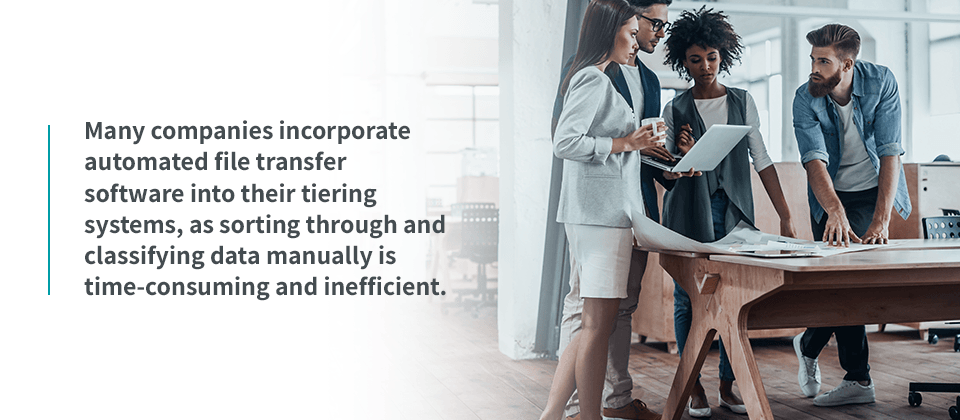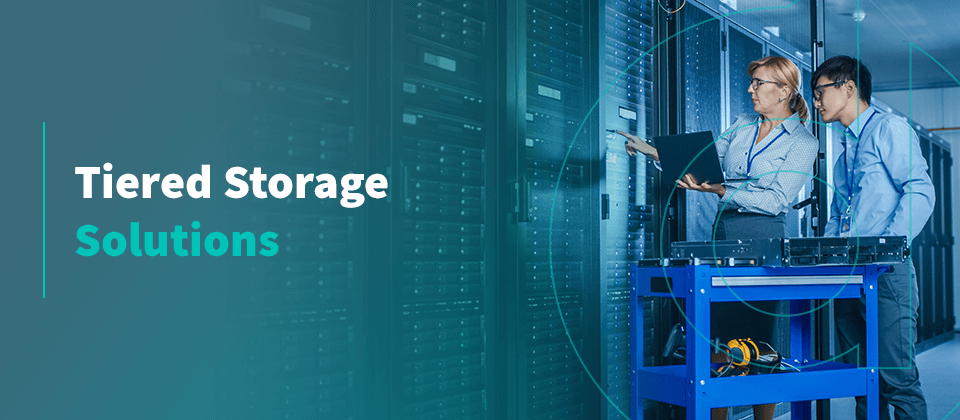Tiered Storage Solutions
With the ever-expanding rate of data creation, companies and data centers must devise more efficient ways to keep up with data management. As technology evolves, so must your company’s approach to your data.
While tiered data storage systems are an excellent way to manage your information throughout the data life cycle, many IT departments fall short in creating effective systems due to the complexity of the task and the costs associated with implementation.
However, when implemented properly, using appropriate equipment and planning, storage tiering can boost your efficiency, save money and protect your organization from data recovery disasters.
What Is Tiered Storage?
Tiered data storage is a system that assigns data to different types of storage media based on four main factors:
- Cost
- Performance
- Recovery
- Capacity
In general, the more tiers you have in your system, the more efficient your data storage strategy will be. Systems with three to five tiers tend to be the most effective, but you can scale the number of tiers you use to fit your organization’s needs.
The main data classifications include:
- Mission-critical data: This is data that is essential for business proceedings and must be accessible with no downtime. Your business constantly uses your mission-critical data, which is why access issues can bring your operation to a halt. Always store your mission-critical data at the highest tier available to ensure immediate retrieval.
- Hot data: Hot data is constantly in use, meaning it’s important to how a business operates. However, hot data is not critical to a business’s operation. Economic consequences like the loss of business may occur if hot data is not readily accessible, but issues will not cease operations. As a result, hot data belongs in high-performance tiers.
- Warm data: Warm data has “cooled” after a few days of use. Easy access to warm data is still important, but cost-effectiveness will be the main priority in tier assignment.
- Cold data: This is data that, while still important for a company to retain, may not require access for long periods, if at all. Access times of a few minutes to several hours are acceptable. Cold data belongs in a company’s lowest tier, which is also the most cost-effective.
These classifications are the basis for each tier.
Tiered data storage is also distinct from hierarchical storage management (HSM), which is specifically concerned with moving data throughout its life cycle. Storage tiering is concerned primarily with the type of storage media the data occupies.

How Tiered Storage Works
The amount of storage space increases with each tier, as more data moves into the lower tiers than the amount that stays at higher tiers. Many companies incorporate automated file transfer software into their tiering systems, as sorting through and classifying data manually is time-consuming and inefficient.
An advanced tiering system could look like this:
- Tier zero: The highest-performing tier. Storage at this tier should be reserved for the most time-sensitive mission-critical data — the information that must be accessed as quickly as possible or else business proceedings will stop. There is absolutely no tolerance for downtime or latency at this tier. Fast solid-state drives (SSDs) or other high-quality storage media like flash are ideal for this tier, as these devices allow for the quickest accessibility with no downtime. You could also create redundancy for this tier to ensure the data is always backed up.
- Tier one: In a five-tier system, tier one is the second-highest performing level. It’s almost as fast as tier zero, but it’s slightly more cost-efficient. Only extremely short delays of a few seconds are acceptable at this tier. Fast disks and flash storage are suitable options for tier one storage media.
- Tier two: Tier two stores hot data like enterprise resource planning (ERP) or customer relationship management (CRM) data. Performance at this tier can range from a high to medium degree. An example of storage media for this tier is a high-capacity, low-cost-per-gigabyte hard drive. This solution can store significantly more data than storage media at higher tiers but still allows for quick data retrieval.
- Tier three: This tier is primarily for storing warm data, like older emails and recent business transactions. This information is still necessary for your business, but affordability becomes more important as a deciding factor at this tier. High-capacity hard drive storage like SATA drives or other spinning drives are good choices for tier three storage, but disks and tape storage that perform at high speeds can also work well.
- Tier four: The lowest tier of your system is where you will store cold data for as long as necessary. Because access time is not important at this tier, cost-effectiveness receives higher priority. However, you also need to ensure your bottom-tier storage media is secure enough to protect your information from would-be attackers. Examples of good tier four storage media include cloud storage, optical media and disk or tape arrays.
Advantages of Tiered Storage
Implementing an efficient tiered storage strategy can benefit your company in many ways, including:
- Increased efficiency and performance: By moving less-sensitive data out of high-performance drives and into the lower tiers, you reduce the demand on those high-power systems. This increased space improves the storage media’s ability to retrieve information at high speeds and keep operations running smoothly.
- Reusable equipment: By implementing a tiered storage system, you can repurpose your old storage devices into storage for your lower tiers.
- Reduced costs: Tiered storage strategies enable you to reuse aging devices, which means you don’t have to buy new storage equipment for your lower tiers. Similarly, by moving your low-priority data into lower tiers, you reduce the amount of high-power storage space you need to pay for.
- Enhanced disaster recovery: An effective tiered storage system can help reduce the amount of data that must be recovered in the event of a disaster. This way, you can decrease the costs associated with maintaining a zero recovery time objective (RTO) and recovery point objective (RPO). By classifying data and separating it based on its necessity, you ensure the information is in the optimal location for future recovery.
Learn More About DataSpan’s Data Storage Solutions Today
If you want to create the best data storage system for your company, DataSpan can help you achieve it. As one of the largest suppliers of data center equipment and services, we will get you where you need to be.
We create data storage options with excellent function and cost reduction in mind. We also offer custom solutions so you can address all your unique concerns. Contact us to learn more about how DataSpan can help you create an optimized data storage system built to grow with your company, or click here to find your nearest representative.

About the Author: Alex von Hassler’s long term focus is the continued testing, learning, and deployment of modern IT solutions. During his years as a DataSpan team member, his responsibilities grew from managing Salesforce CRM to improving system security, creating marketing initiatives, as well as providing continued support to the highly motivated and experienced team in an ever-changing industry. As DataSpan evolves to provide the best-fitting IT solutions to its customers, Alex von Hassler continues to hone his skills in the world of web-based ERP systems, security, and best customer engagement practices. Empowering such a dynamic team with the right tools provides him with enormous gratification.









